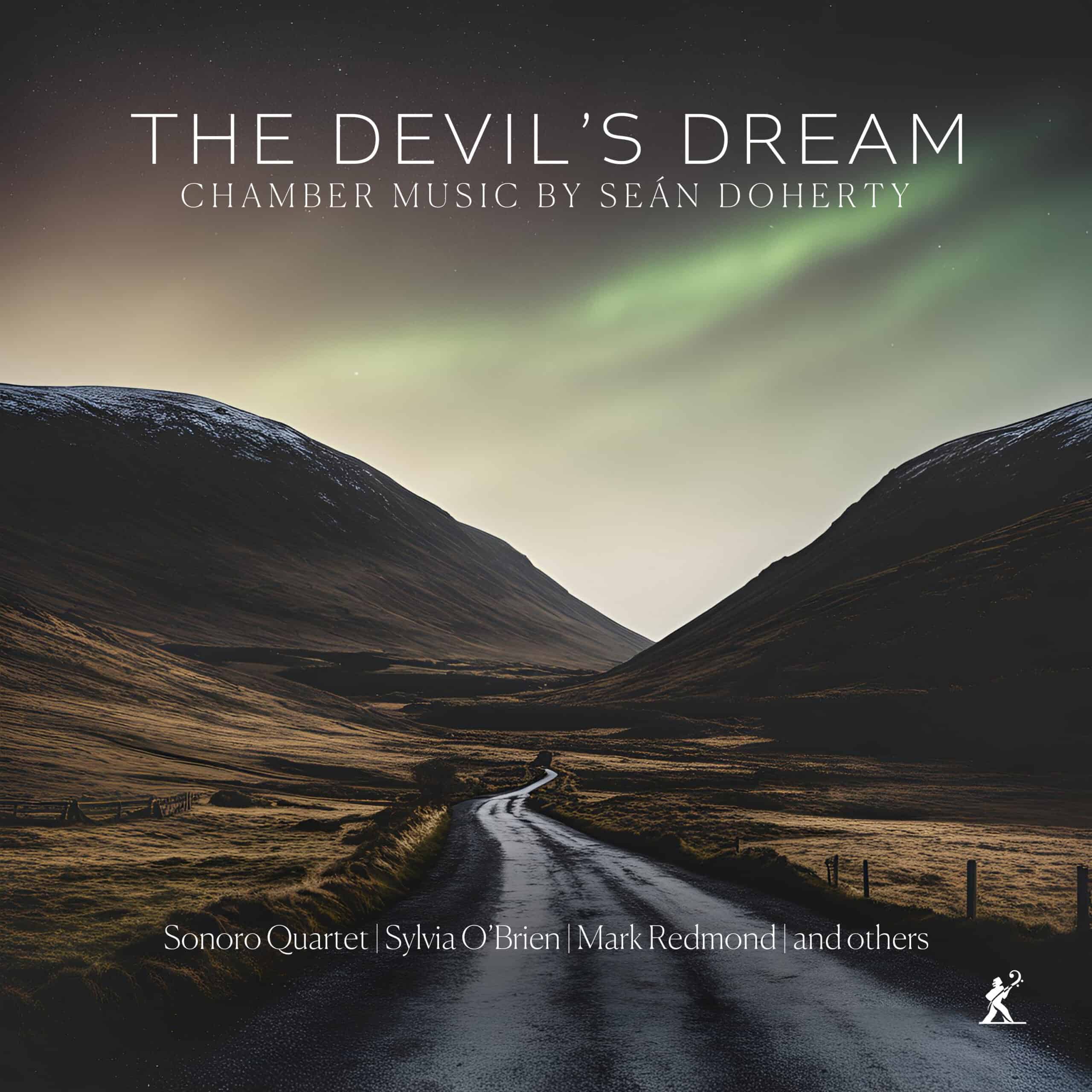The Journal of Music
The challenge for composers who try to incorporate Irish traditional music into a contemporary idiom is how to do so without ending up with a shotgun wedding scenario where both styles seem more in conflict than in harmony. The best experiments in this vein have been those where the composer has looked deep into the essence of traditional music itself for distinctive elements – particularly in relation to intonation, ornamentation and timbre – to magnify and serve as the basis for a more holistic musical language. As a composer who describes himself as ‘at heart, a fiddle player’ and for whom Irish traditional music is his native tongue, Seán Doherty would seem better placed than most to arrive at a successful synthesis.
Many of the pieces on this new album of chamber music entitled The Devil’s Dream certainly reveal evidence of a deep engagement with the tradition. A good example is the first section of Doherty’s String Quartet No. 3, whose subtitle provides the name of the album as a whole. Here, the opening reference to musicians tuning up at a seisiún transitions seamlessly into a drifting texture of slides and other ornaments before re-gathering into the slow air ‘An Londubh’. The rich, drone-based harmonies and microtonal nuances of the accompaniment match beautifully with the slow air whose melodic contours are shared between each member of the quartet.
The album reveals a great sensitivity for textures that are thoroughly contemporary but also feel rooted in the tradition. As a well-known composer of choral music (his album with New Dublin Voices was released recently), Doherty’s sense of voice leading is impeccable and this album contains some outstanding examples of polyphonic writing in a traditional context. The standout piece here is Prof. Boole’s Farewell where three tunes are combined so naturally that one doesn’t even notice the subtle superimposition of three different time signatures. Similar expertly crafted textures feature in Fr. McCarthy’s Lament and towards the end of Paddy’s Rambles Through the Gravel Walks which caps off the album with all the participating musicians playing together.
Indeed Doherty himself is a natural tune composer and this strength comes across in several pieces but perhaps no more so than No Go for uilleann pipes and string quartet, an ambitious reimagining of The Fox Chase, a classic showpiece of the uilleann pipe repertoire. The piece traverses through a series of tunes from a beautiful cascading jig at the beginning to increasingly abstract melodic ideas before ending with a slow air.
Experiments
While Doherty is very sure-footed, even masterful, when dealing with traditional music, it is when the music drifts into more overtly ‘modernist’ sounding material that it doesn’t always convince. For instance, a distorted danse macabre version of a reel in the string quartet recalls some of the unsuccessful neo-Bartókian experiments that Irish composers have perennially felt obliged to attempt. Also, despite the qualities of the tune writing in No Go, some of the more abrasive sections (specifically from 6.29 onwards) feel as if passages of Xenakis had somehow strayed into the score.
There are other moments of unevenness. In Lament for the Poets – a setting of three contemporaneous reflections on the Easter Rising for soprano and string quartet – the rising glissandi that feature the wonderful Sylvia O’Brien as the spéirbhean (a kind of Irish Brunnhilde) reaching into the vocal stratosphere are thrilling. However, the decision to insert a spoken word section of posh-sounding male voices belittling a feminine image of Ireland (a passage from Marianne Moore’s poem ‘Sojourn in the Whale’) in the second song sounds whimsical and undermines the overall seriousness of the settings.
Nevertheless, at its best The Devil’s Dream contains music that places Doherty at the forefront of the most exciting new developments in composition that explore traditional music. The quality of the performances from the Sonoro Quartet, uilleann piper Mark Redmond, soprano Sylvia O’Brien and others is first class and many listeners will surely be impressed at the inspiration that composers such as Doherty continue to find within the tradition.
@divineartrecordingsgroup
A First Inversion Company
Registered Office:
176-178 Pontefract Road, Cudworth, Barnsley S72 8BE
+44 1226 596703
Fort Worth, TX 76110
+1.682.233.4978










![Listen to the full suite of Marcel Dupré’s Variations Sur un Noël, Op. 20 from Alexander Ffinch’s #Expectations release today! listn.fm/expectations [in bio]](https://scontent-dfw5-1.cdninstagram.com/v/t51.71878-15/588904367_2327488161082898_8709236950834211856_n.jpg?stp=dst-jpg_e35_tt6&_nc_cat=105&ccb=7-5&_nc_sid=18de74&efg=eyJlZmdfdGFnIjoiQ0xJUFMuYmVzdF9pbWFnZV91cmxnZW4uQzIifQ%3D%3D&_nc_ohc=b5g9hiAMsPAQ7kNvwFAzaYv&_nc_oc=AdkB89uQb4caMJmfq6K5bEmB-ZcmPwU0IMowaL643vXP8r7ivqTlyPgpIp0DqJZYe8XX_RepHMv9w7JFCc0b6m3c&_nc_zt=23&_nc_ht=scontent-dfw5-1.cdninstagram.com&edm=ANo9K5cEAAAA&_nc_gid=cBLDPiUcLdl88q9tUlxhpg&oh=00_AfkRIYhz1RXYkMlxcLiF1YvZGlq5ubFZSd0BdXm9MPZcKQ&oe=695093AA)

![“the ‘Manteca’ Paraphrase – a rare foray into the two-piano medium but here played double-tracked – exudes a panache of which Dizzy Gillespie would surely have approved.… [a] recital well worth investigating.” —Gramophone Magazine with high praise for Ophelia Gordon's debut release, Kapustin: Between the Lines!](https://scontent-dfw5-3.cdninstagram.com/v/t51.82787-15/598796470_18303255136283342_540941604740887837_n.jpg?stp=dst-jpg_e35_tt6&_nc_cat=108&ccb=7-5&_nc_sid=18de74&efg=eyJlZmdfdGFnIjoiRkVFRC5iZXN0X2ltYWdlX3VybGdlbi5DMiJ9&_nc_ohc=qJeKeEK7ScQQ7kNvwGwvEbZ&_nc_oc=AdkYFWtyXUlUelg7YtcKtU7S8sszyleguqNZH5viU-CLTxBvG-tkI88Pz0udszHIEixenuVmJIW5vSilE3IGp8oa&_nc_zt=23&_nc_ht=scontent-dfw5-3.cdninstagram.com&edm=ANo9K5cEAAAA&_nc_gid=cBLDPiUcLdl88q9tUlxhpg&oh=00_AfmPNaAeziqCloyYcT3vNAcdAWv5FkUw8ovqQGVsMjvumQ&oe=69506E04)